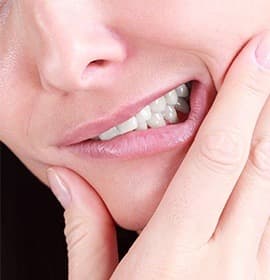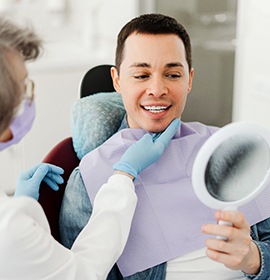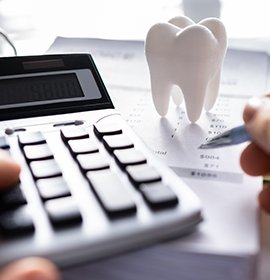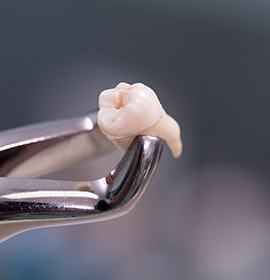Tooth Extractions – Brampton, ON
Painless Removal for Problem Teeth
At Salvaggio Dentistry, we have one primary goal: to help our patients keep and maintain their natural teeth for as long as possible. However, in cases where a tooth is simply damaged beyond repair, an extraction may become necessary. We only use this treatment as a last resort, and should you ever need one, you can trust we’ll do everything we can to ensure your comfort. Plus, if necessary, we can help replace the tooth right away, so you’ll spend as little time as possible with an incomplete smile. Our goal as your dental team is to take the stress out of the situation at every opportunity, so don’t hesitate to get in touch with us if you have any questions about your emergency dental care.
Why Choose Salvaggio Dentistry for Tooth Extractions?
- All extractions performed in-house
- Patient comfort is priority #1
- Extended hours: Get the care you need when YOU need it
Reasons Why Tooth Extractions Are Necessary

Extracting a tooth is never our first choice, but simply removing a problem tooth is often the best solution for:
- Excessive decay that has damaged the majority of a tooth.
- Physical trauma that has made the enamel unable to support a restoration.
- An advanced infection that has weakened the bone needed to hold a tooth in place.
- A stubborn baby tooth that is preventing the adult version from coming in correctly.
The Process of Removing a Tooth

Fortunately for our patients, when we extract a tooth, there is absolutely no pulling involved. Rather, we start by numbing the area. Once you can’t feel anything and you’re ready to begin, we will gently grip the tooth with a pair of dental forceps. Then, we will rock the tooth back and forth, and before you know it, it slips out on its own. This approach is so smooth that most patients don’t even feel their tooth coming out!
Tooth Extraction Aftercare

Once you return home and the numbing agent wears off, it’s normal to feel some soreness. To help keep you comfortable during the healing process, we will provide you with aftercare instructions, like:
- Taking OTC pain medication as directed
- Eating only soft foods, like plain yogurt
- Brushing and flossing carefully around the extraction site
- Not smoking, drinking alcohol, or spitting
- Keeping your head elevated while you sleep
Around the three-day mark, you should feel your symptoms start to subside. A week after the procedure, you should be able to resume your regular diet and daily routine. Of course, if your symptoms get worse instead of better, then you shouldn’t hesitate to contact us – we can help!
Do you have any lingering questions about tooth extractions? If so, get in touch with us so we can provide you with the answers you’re looking for!
Understanding the Cost of Tooth Extractions

Before you get your tooth removal, you’ll want to confirm the treatment’s price. This approach will ensure your procedure fits within your expected budget. That being said, you’ll need to consult Dr. Salvaggio for the final estimate; the cost of tooth extractions varies. Our team can then find ways to make care more affordable, all while outlining its price factors, dental insurance, etc. Please keep reading to learn more, or call us in the coming days.
Factors That Can Affect Tooth Extraction Cost

Dr. Salvaggio will closely assess your tooth (or teeth) at your consultation visit. That way, he can check several factors affecting your final treatment cost. These include the following:
- Number of Extracted Teeth – Naturally, the number of teeth that need extraction will impact your treatment price. As that number rises, so will your procedure’s cost.
- Type/Location of Tooth – The cost of extraction is also influenced by a tooth’s type or location. For instance, extracting front teeth is often less expensive because doing so is easier.
- Complexity of Treatment – All tooth extractions are either simple or complex in nature. Simple kinds tend to be easy and inexpensive, while complex ones are more costly.
- Tooth Replacement Options – If you decide to get a tooth replacement after extraction, your treatment will cost more. Whether this replacement is a denture, dental bridge, or dental implant also affects the degree of the price increase.
Does Dental Insurance Cover Tooth Extractions?

Dental insurance normally will cover tooth extractions, as most plans see the removal as crucial. A given policy will even meet 50% of an extraction’s cost in many cases. With that said, remember to meet your plan’s deductible (and/or maximum) to enjoy any benefits.
At the same time, exceptions to the points above exist. Your dental plan may limit extraction coverage, only cover certain teeth, etc. Given these facts, please confirm your policy’s benefits before you commit to anything. Our dental team can help you do so by contacting your insurance provider.
How to Make Tooth Extractions Affordable

If you lack dental insurance, please don’t panic; a tooth extraction can still be affordable. You’ll just need to rely on our practice’s other payment options for help! By choosing the right one, your tooth removal should be simple, easy, and budget-friendly.
A good example of such an option is our dental financing service. By working with DentalCard (a 3rd party financier), we allow patients to divide treatment costs into monthly payments. This approach would let you break down your tooth extraction’s price into something you can manage.
In the end, your tooth extraction shouldn’t have to put you in debt or “break the bank.” Visit our office and let us help you finance your treatment!
Tooth Extraction FAQs
Do you want to know more about dental extractions? Our expert team at Salvaggio Dentistry has answered some of the most common questions about tooth removal below. We know extractions can seem slightly scary, so we hope this FAQ section helps ease any nerves by addressing your concerns or curiosity. Whether you are a returning or new patient, feel free to give us a call if you have additional questions!
What's the Difference Between Local Anesthesia and Sedation? Can I Be Put to Sleep?
Both local anesthesia and dental sedation are utilized to help ensure patients feel comfortable throughout dental procedures. However, there are important differences between the two.
Local anesthesia is used by dentists to numb a small area of the mouth to prevent pain. Applied either topically or via injection, this type of anesthesia is often used for simple tooth extractions.
In addition to controlling pain, sedation can also be used to ease dental anxiety or help young patients who have trouble sitting still for long periods of time. There are several different forms of dental sedation, including oral conscious sedation, nitrous oxide, and IV sedation.
While most tooth extractions do not require the patient to be put to sleep, dental sedation may be used for more complex extraction cases or if requested by the patient.
What Is Recovery Like After a Tooth Extraction?
You can expect to fully recover from a tooth extraction in about 7 to 10 days. You may experience some swelling and mild pain immediately following the extraction procedure. However, taking pain medication as directed by your dentist and applying an ice pack to your face can help reduce any discomfort.
Practicing good oral hygiene is important to prevent an infection from occurring around the extraction site. Gently rinse with lukewarm water to help clean the area. When you brush and floss your teeth, be sure to avoid the area where your tooth was removed.
Finally, stick to eating soft foods like soup, applesauce, and yogurt for the first few days following an extraction, and avoid drinking through a straw.
Should I Replace My Missing Tooth After Extraction?
Replacing a missing tooth can not only boost your appearance but also benefit your oral health. When a tooth goes missing or is removed, nearby teeth can gradually shift into the remaining gap. Dental drift can contribute to bite problems and increase the risk of gum disease and tooth decay. At Salvaggio Dentistry, we offer a variety of restorative options to replace missing teeth, including partial and full dentures, bridges, and dental implants.
How Much Is a Consultation?
At Salvaggio Dentistry, we are happy to offer free consultations for tooth extractions. During this initial visit, one of our highly-skilled dentists will perform a careful examination to determine if any damaged or infected teeth need to be removed. If a dental extraction is recommended, your dentist will give you more details about the process and answer any questions you may have.
Do You Accept Dental Insurance for Tooth Extractions?
We accept most major dental insurance plans and will even file the insurance claim paperwork on your behalf so you do not have to worry about the hassle! While every plan is different, most dental insurance providers cover 80% of the cost of basic services like tooth extractions. If you have questions about your specific policy, do not hesitate to ask our staff. We are always happy to help customers navigate the particulars of their dental insurance plan and maximize their benefits.
